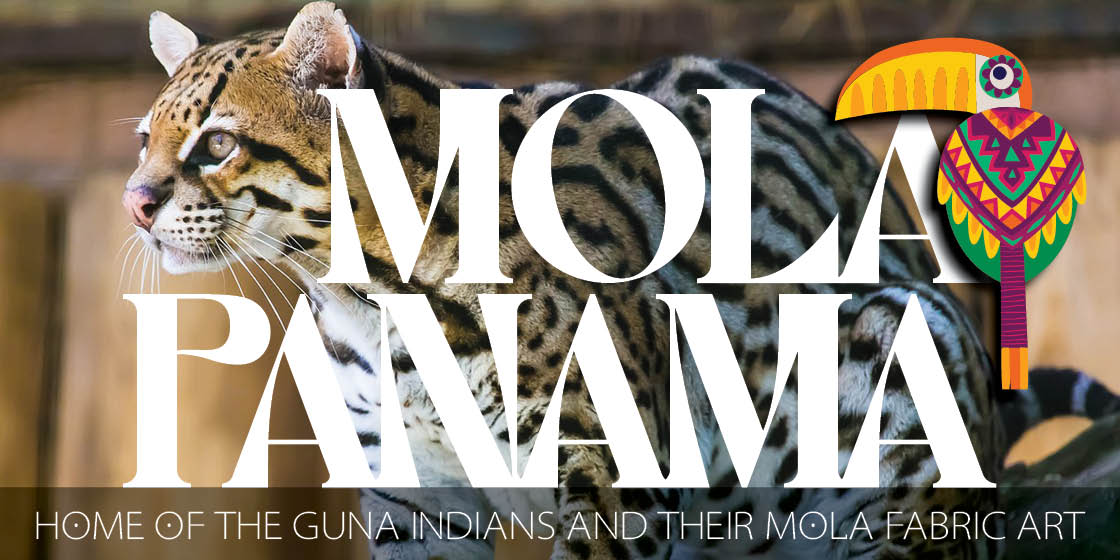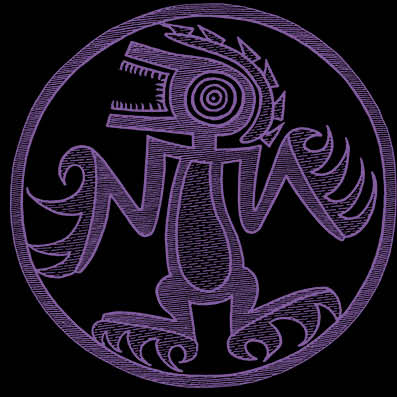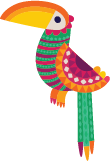The Mola Art of Panama: Part 3
A GBD Microsite ![]() Mola Art of Panama
Mola Art of Panama

ON THIS PAGE
Guna Indian Mola Fabric Art Gallery No. 2
The Birds of Panama Photo Gallery
The Guna Indian Language: Everyday Words
The Birds of Panama: The Honeycreeper
Pre-Columbian Panamanian Pottery
Mola Gallery 2:
The Birds of Panama Gallery:
Panamá is home and a place of pilgrimage to more than 1,000 bird species. The tropical isthmus hosts diverse migratory and endemic birds due to its geographic location between North and South America and the Pacific and Atlantic oceans. Panamá is home to 10% of the world’s known bird species and 107 endemic species and has more of a variety of birds than the United States and Canada combined. Panamá is also one of the five migratory bird corridors in the world. All that makes Panamá the perfect year-round destination for bird-watching, though each season may bring different sightings. From endemic to migratory birds escaping the North and South American winters, Panamá is a sanctuary of color and song. These parks also reside within the Mesoamerican Biological Corridor, a conservation effort protecting the biodiversity hotspots. Because of this, these parks have become a haven for endemic and migratory birds. Internet Source.

The Guna Language (Dulegaya): Everyday Words
Here are a few Mola words with their English translations. Learn more about the Guna language here.
Mola means shirt or piece of clothing.
Tulemola means Kuna people clothing.
Ogob is a coconut.
Skungit is a lobster.
Mor Ginnid is the liberation party day.
Sahila is the villageleader.
Comarca is a district.
Erragon is a god.
Nuchus is a small holy wooden doll.
Poni is an evil spirit.
Acuadop means Rock Island.
Kuna Yala means Kuna land.
Ico-inna is a feast about puberty/wedding.
Mor Ginnid is the liberation party day.
Tilapia is a fish.
Chichas are boiled drinks.
Congresos is a town meeting.
Cocoloco is a coconut with rum

The Birds of Panama: The Honeycreeper
 Any of four species of tropical Western Hemisphere birds of the family Thraupidae, order Passeriformes. Many honeycreepers feed on nectar, and some are called sugarbirds. All honeycreepers are small, and many have thin, downcurved bills; the tongue is brushy and may be double-tubed. Most are brilliantly coloured, especially the males; for example, the male purple honeycreeper (Cyanerpes caeruleus), an active, acrobatic little bird that frequents gardens and woodlands in Panama and parts of northern South America, is a stunning blue with black mask and wings; the female is green. The male of the green honeycreeper (Chlorophanes spiza) of Central America and northern South America sports glossy blue-green plumage and a black face mask. Both sexes have a yellow bill and red eyes. The male of the red-legged, or blue, honeycreeper (Cyanerpes cyaneus), which ranges from Cuba and Mexico to Ecuador and southern Brazil, is shiny blue in its breeding plumage, with black upper parts and mask. Honeycreepers tend to build open, well-concealed, cup-shaped nests in trees. Internet Resource
Any of four species of tropical Western Hemisphere birds of the family Thraupidae, order Passeriformes. Many honeycreepers feed on nectar, and some are called sugarbirds. All honeycreepers are small, and many have thin, downcurved bills; the tongue is brushy and may be double-tubed. Most are brilliantly coloured, especially the males; for example, the male purple honeycreeper (Cyanerpes caeruleus), an active, acrobatic little bird that frequents gardens and woodlands in Panama and parts of northern South America, is a stunning blue with black mask and wings; the female is green. The male of the green honeycreeper (Chlorophanes spiza) of Central America and northern South America sports glossy blue-green plumage and a black face mask. Both sexes have a yellow bill and red eyes. The male of the red-legged, or blue, honeycreeper (Cyanerpes cyaneus), which ranges from Cuba and Mexico to Ecuador and southern Brazil, is shiny blue in its breeding plumage, with black upper parts and mask. Honeycreepers tend to build open, well-concealed, cup-shaped nests in trees. Internet Resource

![]()
Pre-Columbia Pottery from Panama
The pottery designs shown below were discovered in Coclé province in central Panama. The term pre-Columbian is used to refer to the cultures of the Americas in the time before significant European influence. The term is often used in discussions of the great indigenous civilizations of the Americas. (See more artwork from the Pre-Columbian era here, on another GBD Microsite).








All of the Mola images are from the site ethnix.com.
Use the gallery images below to view other pages in this series:

